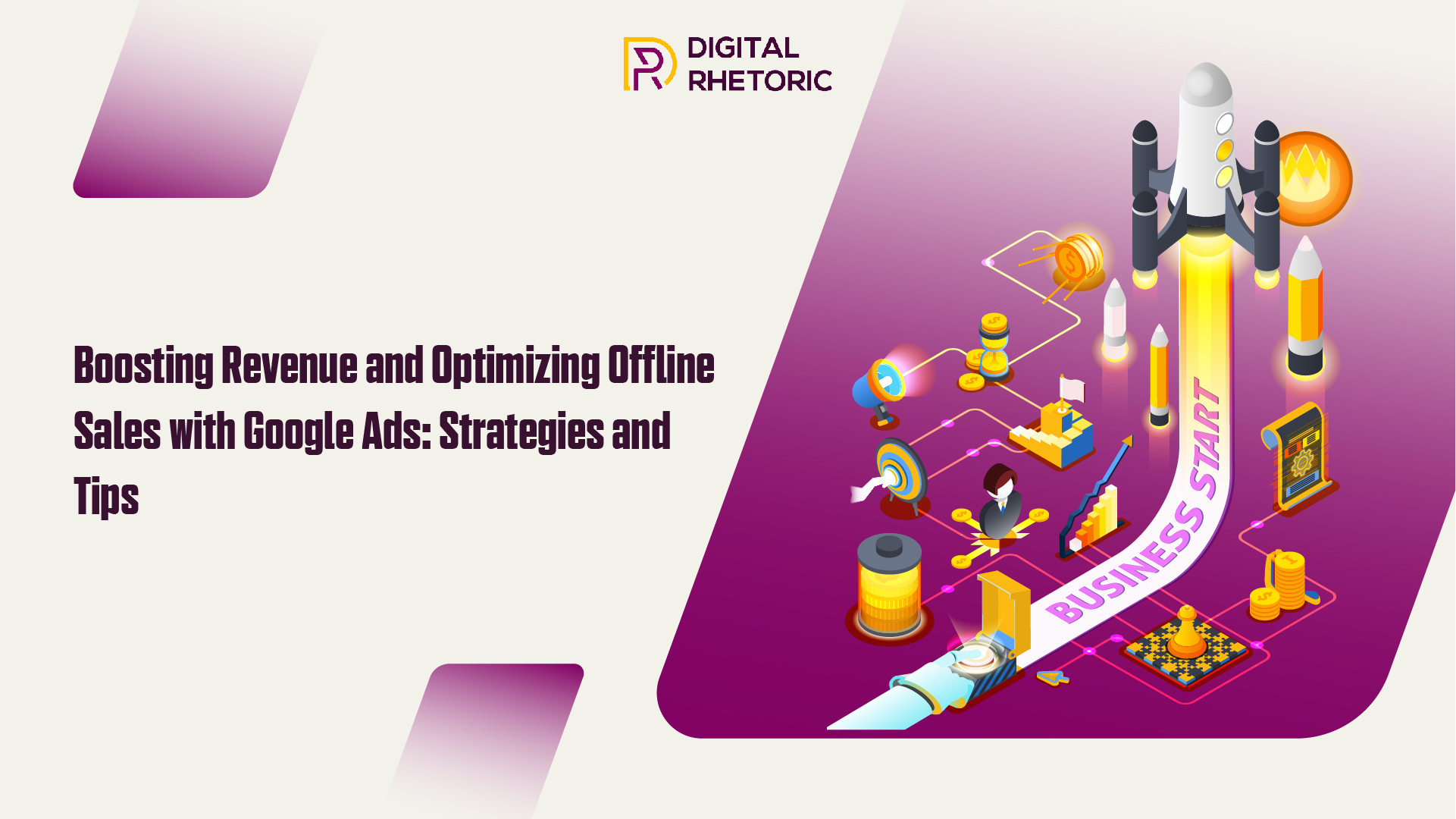Boosting Revenue and Optimizing Offline Sales with Google Ads: Strategies and Tips
- Sanjay Thakore
- May 4, 2024
- Blog
- 0 Comments

Local business marketing with Google Ads in a competitive market brings powerful revenue growth and a proven way to increase profits through advertising. Companies can use these tools to bridge their work with a target audience online and in an offline format, and digital marketing can coexist effectively with store/organization success. This marketing strategy not only increases visibility but also increases the overall income.
Understanding Offline Conversion Tracking
Offline conversion tracking via Google Ads is the cornerstone of a company’s revenue development initiatives. With conversion tracking, businesses can link clicks on their online advertisements to actual sales made in the real world. This enables them to track what customers are doing after clicking through ads, providing sufficient insight to measure the effects of online advertising on physical store profits.
The process of monitoring offline conversions is crucial to optimizing revenue growth strategies, and systematically boosting sales. Much more importantly, companies can correctly estimate the true impact of digital advertising on in-store revenues. Marketing departments can operate with better insight and tailor marketing strategies to achieve better return on investment through high-potential channels.
Setting Up Offline Conversion Tracking
- Enable Conversion Tracking: In Google Ads, set up offline conversion tracking to begin the process. This is foundational in maximizing sales with Google Ads.
- Generate and Save GCLID: Ensure that your website captures the Google Click ID (GCLID) when visitors click on your ads. This unique identifier is crucial for linking online interactions to offline conversions.
- Integrate with CRM: Connect your CRM system to Google Ads. This integration is key for tracking the customer journey from ad clicks to offline purchases, aligning with sales strategies that close the loop on customer interactions.
- Import Offline Conversions: Regularly upload offline conversion data from your CRM back to Google Ads. Use the GCLID to match offline transactions with the specific ad interactions that generated them.
- Analyze and Optimize: Utilize the conversion data to analyze the effectiveness of your ads. Follow Google Ads best practices to refine targeting, bid strategies, and ad creatives to further enhance campaign performance and sales outcomes.
- Continuous Improvement: Regularly review and update your tracking and sales strategies based on the data and insights gathered, ensuring ongoing optimization of your campaigns for maximum impact on sales.
Targeting the Right Audience
The use of targeted ad campaigns in maximizing sales with Google Ads, as campaigns to increase traffic to offline stores is from that exception. Following Google Ads best practices, businesses will be able to target demography and location, and, respectively, customers most likely to appear at the physical spot. Not only does it make it possible to increase the effectiveness of ad spending but also allows the e-commerce businesses to significantly increase their offline sales. Strong sales strategies accompanied by thorough information about the customers ensure that the ad is saturated with data that is relevant to the target utility.
Leveraging Local Campaigns
Google Ads local campaigns are the most vital element of local businesses marketing with Google Ads, specifically designed to boost sales by increasing the customer’s influx to a physical business location. This campaign ensures that your store constantly shows as the first address for all local customers on different Google apps, making your business more visible and maximizing sales with Google ads through direct purchases from local buyers.
- Enable Location Extensions: Add location extensions to your ads to show your store address and hours directly in the ad, enhancing local visibility.
- Target Geographically: Focus your ads on specific geographic areas where your potential customers live or work to increase relevancy and foot traffic.
- Use Local Keywords: Incorporate local keywords related to your city, neighbourhood, or landmarks to capture the attention of local searchers.
- Optimize for Mobile: Ensure your ads are mobile-friendly, considering most local searches are performed on mobile devices.
- Schedule Ads for Peak Times: Run your ads during business hours or peak times when potential customers are most likely to visit your area.
- Monitor and Adjust Bids: Use location targeting to adjust bids for areas with high sales potential, maximizing your ad spend efficiency.
- Analyze Performance Regularly: Continuously review the performance of your local campaigns and adjust strategies as necessary to improve results.
Using Smart Bidding Strategies
Google Ads also has smart bidding, such as Target ROAS, which is according to Google Ads best practices because it adjusts the bids according to the projected return on ad spend. Moreover, priority is given to bids that are expected to result in offline sales through conversion tracking, therefore making the advertisements more efficient.
- Set Realistic Targets: Define clear ROAS targets based on historical data to ensure your bidding strategy aligns with actual business outcomes, crucial for increasing profits through advertising.
- Use Geo-Targeting: Tailor bids for regions with higher sales potential to optimize advertising impact in local business marketing with Google Ads.
- Employ Bid Modifiers: Adjust bids based on device, time of day, and location to better capture high-intent customers and boost sales.
- Implement Smart Bidding: Utilize Google Ads smart bidding strategies such as Enhanced CPC and Target CPA, which automatically adjust bids to maximize conversion value.
- Focus on High-Performing Keywords: Increase bids for keywords that historically lead to offline conversions, ensuring your ads appear in competitive ad spaces.
- Monitor and Adjust Regularly: Continuously analyze performance data to refine bidding strategies and ensure maximum efficiency and effectiveness in driving offline revenue.
Optimizing Ad Creative and Messaging
When it comes to boosting sales through advertising, it is highly recommended to link ad creatives to in-store promotions or events. By doing so, it is possible to adopt one of the most successful local business marketing with Google Ads, which can increase sales up to twofold. It is also valuable to test different ad formats, like banners, video, responsive ads, and messages to understand what your audience is best responsive to. Such an approach will enable you to understand the best way to get users to engage with you offline and optimize your spending accordingly, making your advertising efforts twice more effective.
Integrating Online and Offline Customer Journeys
Connecting online and offline channels into a seamless customer experience ensures brand experience consistency and strengthens customer loyalty. It supports the transition from offline shopping to online searching and vice versa, leading to higher satisfaction and retention levels. Moreover, the integration creates opportunities for more efficient data gathering, which facilitates interaction personalization and marketing advancements.
- Deploy QR Codes: Place QR codes in-store that link to online content, exclusive deals, or digital loyalty programs to enhance customer engagement.
- Online Exclusive Offers: Promote online-exclusive offers that customers can redeem in-store, driving online traffic to physical locations.
- Click-and-Collect Services: Implement a click-and-collect service where customers buy online and pick up in-store, seamlessly integrating both channels.
- In-Store Digital Signage: Use digital signage in physical stores to promote online campaigns, social media contests, or special online-only products.
- Event Promotion: Use online platforms to promote in-store events, encouraging online followers to visit brick-and-mortar locations.
- Mobile App Integration: Develop a mobile app that enhances the in-store experience with features like in-store navigation, product information, and mobile-exclusive discounts.
- Social Media Check-ins: Encourage customers to check in on social media when they visit your store to receive special offers or discounts, promoting both online engagement and in-store traffic.
Analyzing and Iterating
Importantly, it is critical to analyze data obtained from the offline conversions to improve the ad campaigns perpetually. Indeed, this process helps businesses see which strategies produce real sales, and the data is also used to optimize the advertising budget. Therefore, it is recommended to set regular review periods – for example, after every month or quarter – during which one would explore the performance metrics for both online and offline channels. As a result, businesses would be able to refine the target audiences, banner locations, and messages, with future sales being likely increased.
Staying Updated with Google’s Tools and Features
It is also critical to remain informed about the new tools and features that Google is continuously developing. You can achieve that by subscribing to relevant newsletters or following knowledgeable blogs on the subject. Such a proactive attitude is likely to guarantee that you incorporate the newest Google Ads features and use their full potential to keep your campaigns competitive in the digital advertising market.
Conclusion
For more in-depth insights and practical tips on enhancing your digital marketing strategies with Google Ads, visit Digital Rhetoric. Stay ahead by learning from experts—subscribe today to receive updates directly to your inbox and ensure you never miss out on the latest tools and tactics to drive your business forward. Act now!

